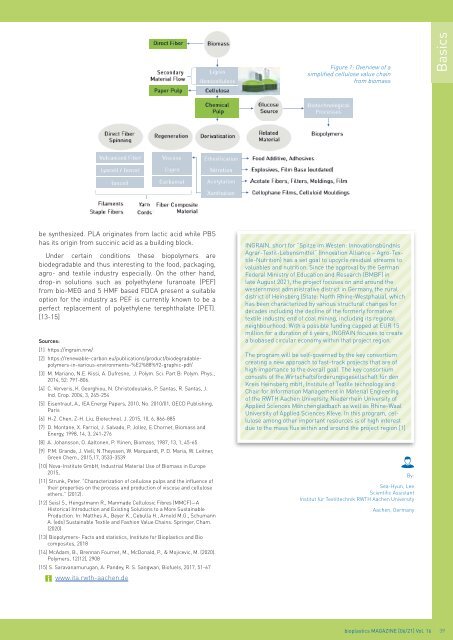Issue 06/2021
Highlights: Coating Films, Flexibles, Bags Basics: Cellulose based bioplastics
Highlights:
Coating
Films, Flexibles, Bags
Basics: Cellulose based bioplastics
Create successful ePaper yourself
Turn your PDF publications into a flip-book with our unique Google optimized e-Paper software.
Figure 1: Overview of a<br />
simplified cellulose value chain<br />
from biomass<br />
Basics<br />
be synthesized. PLA originates from lactic acid while PBS<br />
has its origin from succinic acid as a building block.<br />
Under certain conditions these biopolymers are<br />
biodegradable and thus interesting to the food, packaging,<br />
agro- and textile industry especially. On the other hand,<br />
drop-in solutions such as polyethylene furanoate (PEF)<br />
from bio-MEG and 5 HMF based FDCA present a suitable<br />
option for the industry as PEF is currently known to be a<br />
perfect replacement of polyethylene terephthalate (PET).<br />
[13-15]<br />
Sources:<br />
[1] https://ingrain.nrw/<br />
[2] https://renewable-carbon.eu/publications/product/biodegradablepolymers-in-various-environments-%E2%88%92-graphic-pdf/<br />
[3] M. Mariano, N.E. Kissi, A. Dufresne, J. Polym. Sci. Part B: Polym. Phys.,<br />
2014, 52: 791-8<strong>06</strong>.<br />
[4] C. Ververis, K. Georghiou, N. Christodoulakis, P. Santas, R. Santas, J.<br />
Ind. Crop. 2004, 3, 245-254<br />
[5] Eisentraut, A., IEA Energy Papers, 2010, No. 2010/01, OECD Publishing,<br />
Paris<br />
[6] H-Z. Chen, Z-H. Liu, Biotechnol. J. 2015, 10, 6, 866-885<br />
[7] D. Montane, X. Farriol, J. Salvado, P. Jollez, E.Chornet, Biomass and<br />
Energy, 1998, 14, 3, 241-276<br />
[8] A. Johansson, O. Aaltonen, P. Ylinen, Biomass, 1987, 13, 1, 45-65<br />
[9] P.M. Grande, J. Viell, N.Theyssen, W. Marquardt, P. D. Maria, W. Leitner,<br />
Green Chem., 2015,17, 3533-3539<br />
[10] Nova-Institute GmbH, Industrial Material Use of Biomass in Europe<br />
2015,<br />
[11] Strunk, Peter. “Characterization of cellulose pulps and the influence of<br />
their properties on the process and production of viscose and cellulose<br />
ethers.” (2012).<br />
[12] Seisl S., Hengstmann R., Manmade Cellulosic Fibres (MMCF)—A<br />
Historical Introduction and Existing Solutions to a More Sustainable<br />
Production. In: Matthes A., Beyer K., Cebulla H., Arnold M.G., Schumann<br />
A. (eds) Sustainable Textile and Fashion Value Chains. Springer, Cham.<br />
(2020)<br />
[13] Biopolymers- Facts and statistics, Institute for Bioplastics and Bio<br />
composites, 2018<br />
[14] McAdam, B., Brennan Fournet, M., McDonald, P., & Mojicevic, M. (2020).<br />
Polymers, 12(12), 2908<br />
[15] S. Saravanamurugan, A. Pandey, R. S. Sangwan, Biofuels, 2017, 51-67<br />
www.ita.rwth-aachen.de<br />
INGRAIN, short for “Spitze im Westen: Innovationsbündnis<br />
Agrar-Textil-Lebensmittel” (Innovation Alliance – Agro-Textile-Nutrition)<br />
has a set goal to upcycle residual streams to<br />
valuables and nutrition. Since the approval by the German<br />
Federal Ministry of Education and Research (BMBF) in<br />
late August <strong>2021</strong>, the project focuses on and around the<br />
westernmost administrative district in Germany, the rural<br />
district of Heinsberg (State: North Rhine-Westphalia), which<br />
has been characterized by various structural changes for<br />
decades including the decline of the formerly formative<br />
textile industry, end of coal mining, including its regional<br />
neighbourhood. With a possible funding capped at EUR 15<br />
million for a duration of 6 years, INGRAIN focuses to create<br />
a biobased circular economy within that project region.<br />
The program will be self-governed by the key consortium<br />
creating a new approach to fast-track projects that are of<br />
high importance to the overall goal. The key consortium<br />
consists of the Wirtschaftsförderungsgesellschaft für den<br />
Kreis Heinsberg mbH, Institute of Textile technology and<br />
Chair for Information Management in Material Engieering<br />
of the RWTH Aachen University, Niederrhein University of<br />
Applied Sciences Mönchengladbach as well as Rhine-Waal<br />
University of Applied Sciences Kleve. In this program, cellulose<br />
among other important resources is of high interest<br />
due to the mass flux within and around the project region.[1]<br />
By:<br />
Sea-Hyun, Lee<br />
Scientific Assistant<br />
Institut für Textiltechnik RWTH Aachen University<br />
Aachen, Germany<br />
bioplastics MAGAZINE [<strong>06</strong>/21] Vol. 16 39

















